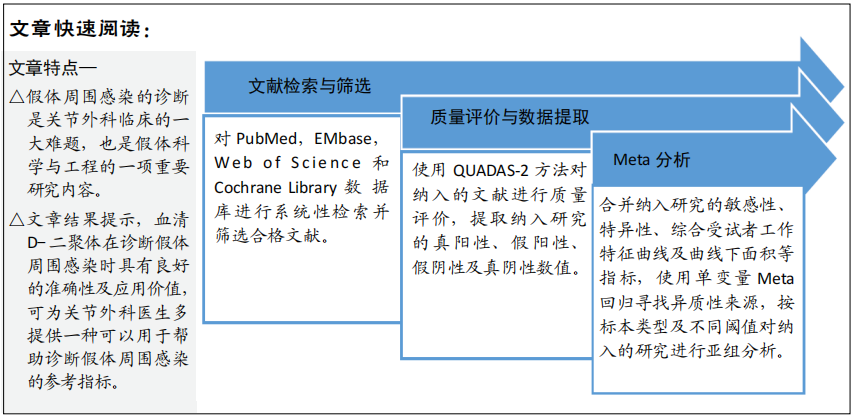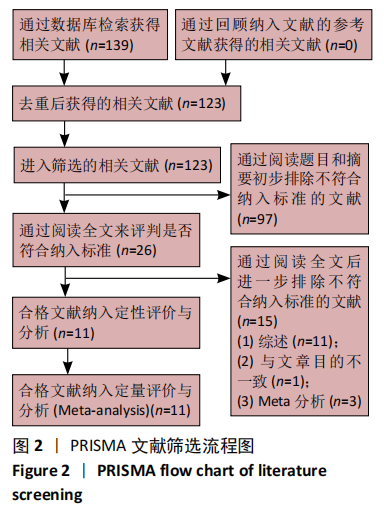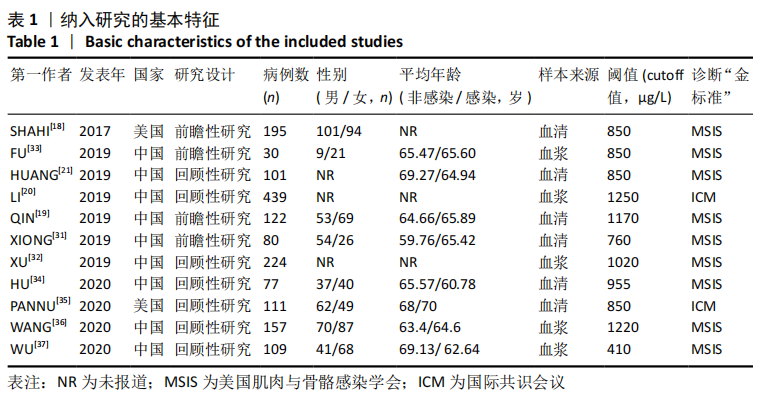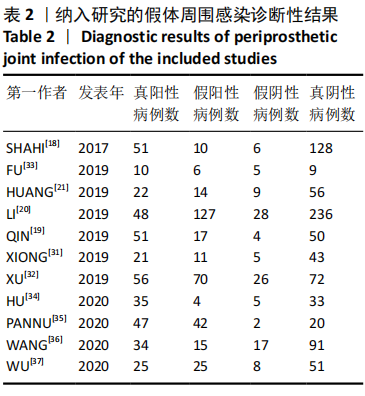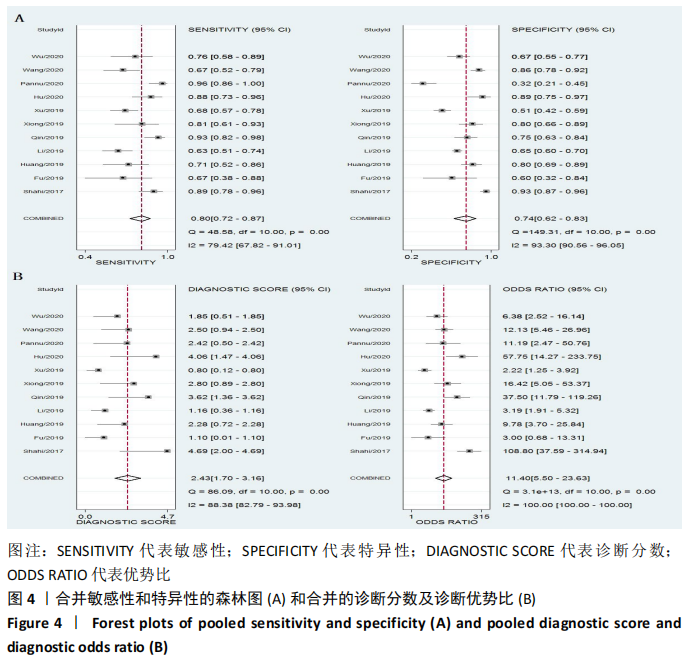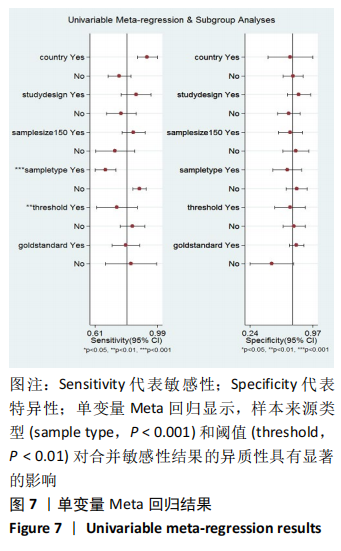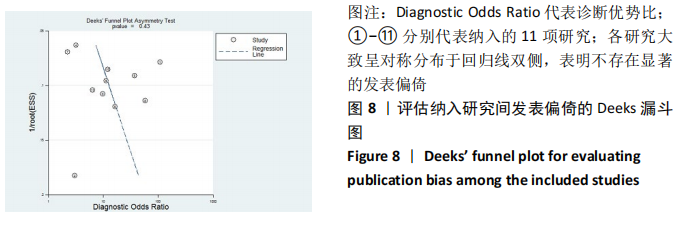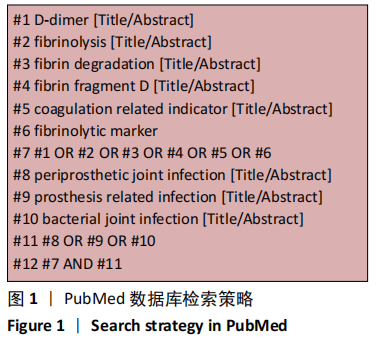[1] KURTZ S, ONG K, LAU E, et al. Projections of primary and revision hip and knee arthroplasty in the United States from 2005 to 2030. J Bone Joint Surg Am. 2007;89(4):780-785.
[2] JAFARI SM, COYLE C, MORTAZAVI SMJ, et al. Revision hip arthroplasty: infection is the most common cause of failure. Clin Orthop Relat Res. 2010;468(8):2046-2051.
[3] URISH K L, QIN Y, SALKA B, et al. Comparison of readmission and early revision rates as a quality metric in total knee arthroplasty using the Nationwide Readmission Database. Ann Transl Med. 2020;8(11):687.
[4] PARVIZI J, PAWASARAT IM, AZZAM KA, et al. Periprosthetic joint infection. J Arthroplasty. 2010; 25(6):103-107.
[5] BOZIC KJ, KURTZ SM, LAU E, et al. The epidemiology of revision total knee arthroplasty in the United States. Clin Orthop Relat Res. 2010,468(1):45-51.
[6] KAPADIA BH, BERG RA, DALEY JA, et al. Periprosthetic joint infection. Lancet. 2016;387(10016):386-394.
[7] FINK B, ANAGNOSTAKOS K, WINKLER H. Periprosthetic Joint Infection. BioMed Res Int. 2019;2019:1-2.
[8] FEHRING TK, ODUM SM, BEREND KR, et al. Failure of irrigation and débridement for early postoperative periprosthetic infection. Clin Orthop Relat Res. 2013;471(1):250-257.
[9] BABIS GC. Another candidate marker for preoperative diagnosis of periprosthetic joint infection. J Bone Joint Surg. 2019;101(7):e30.
[10] PARVIZI J, ZMISTOWSKI B, BERBARI E F, et al. New definition for periprosthetic joint infection: from the Workgroup of the Musculoskeletal Infection Society. Clin Orthop Relat Res. 2011;469(11):2992-2994.
[11] ZMISTOWSKI B, DELLA VC, BAUER TW, et al. Diagnosis of periprosthetic joint infection. J Arthroplasty. 2014;29(2 Suppl):77-83.
[12] LI C, OJEDA-THIES C, TRAMPUZ A. Culture of periprosthetic tissue in blood culture bottles for diagnosing periprosthetic joint infection. BMC Musculoskelet Disord. 2019;20(1):299.
[13] MEERMANS G, HADDAD F S. Is there a role for tissue biopsy in the diagnosis of periprosthetic infection? Clin Orthop Relat Res. 2010;468(5):1410-1417.
[14] SALEH A, GEORGE J, FAOUR M, et al. Serum biomarkers in periprosthetic joint infections. Bone Joint Res. 2018;7(1):85-93.
[15] DEIRMENGIAN C, KARDOS K, KILMARTIN P, et al. Diagnosing periprosthetic joint infection: has the era of the biomarker arrived? Clin Orthop Relat Res. 2014;472(11):3254-3262.
[16] PIPER KE, FERNANDEZ-SAMPEDRO M, STECKELBERG KE, et al. C-reactive protein, erythrocyte sedimentation rate and orthopedic implant infection. PLoS One. 2010;5(2):e9358.
[17] PARVIZI J, TAN TL, GOSWAMI K, et al. The 2018 Definition of Periprosthetic Hip and Knee Infection: An Evidence-Based and Validated Criteria. J Arthroplasty. 2018;33(5):1309-1314.
[18] SHAHI A, KHEIR MM, TARABICHI M, et al. Serum d-dimer test is promising for the diagnosis of periprosthetic joint infection and timing of reimplantation. J Bone Joint Surg. 2017;99(17):1419-1427.
[19] QIN L, LI F, GONG X, et al. Combined measurement of d-dimer and c-reactive protein levels: highly accurate for diagnosing chronic periprosthetic joint infection. J Arthroplasty. 2020;35(1):229-234.
[20] LI R, SHAO H, HAO L, et al. Plasma fibrinogen exhibits better performance than plasma d-dimer in the diagnosis of periprosthetic joint infection. J Bone Joint Surg. 2019;101(7):613-619.
[21] HUANG J, ZHANG Y, WANG Z, et al. The serum level of D-Dimer is not suitable for distinguishing between prosthetic joint infection and aseptic loosening. J Orthop Surg Res. 2019;14(1):407.
[22] MOHER D, LIBERATI A, TETZLAFF J, et al. Preferred reporting items for systematic reviews and meta-analyses: the PRISMA statement. BMJ. 2009;339:b2535.
[23] WHITING PF, RUTJES AWS, WESTWOOD ME, et al. QUADAS-2: a revised tool for the quality assessment of diagnostic accuracy studies. Ann Int Med. 2011;155(8):529.
[24] VAN HOUWELINGEN HC, ZWINDERMAN KH, STIJNEN T. A bivariate approach to meta-analysis. Stat Med. 1993;12(24):2273-2284.
[25] REITSMA JB, GLAS AS, RUTJES AWS, et al. Bivariate analysis of sensitivity and specificity produces informative summary measures in diagnostic reviews. J Clin Epidemiol. 2005;58(10):982-990.
[26] CHU H, COLE SR. Bivariate meta-analysis of sensitivity and specificity with sparse data: a generalized linear mixed model approach. J Clin Epidemiol. 2006;59(12):1331-1332.
[27] RILEY RD, ABRAMS KR, SUTTON AJ, et al. Bivariate random-effects meta-analysis and the estimation of between-study correlation. BMC Med Res Methodol. 2007;7(1):3.
[28] WACKER C, PRKNO A, BRUNKHORST F M, et al. Procalcitonin as a diagnostic marker for sepsis: a systematic review and meta-analysis. Lancet Infect Dis. 2013;13(5):426-435.
[29] HIGGINS JPT, THOMPSON SG, DEEKS JJ, et al. Measuring inconsistency in meta-analyses. BMJ. 2003;327(7414):557-560.
[30] DEEKS JJ, MACASKILL P, IRWIG L. The performance of tests of publication bias and other sample size effects in systematic reviews of diagnostic test accuracy was assessed. J Clin Epidemiol. 2005;58(9):882-893.
[31] XIONG L, LI S, DAI M. Comparison of D-dimer with CRP and ESR for diagnosis of periprosthetic joint infection. J Orthop Surg Res. 2019;14(1):240.
[32] XU H, XIE J, HUANG Q, et al. Plasma fibrin degradation product and d-dimer are of limited value for diagnosing periprosthetic joint infection. J Arthroplasty. 2019;34(10):2454-2460.
[33] FU J, NI M, CHAI W, et al. Synovial fluid viscosity test is promising for the diagnosis of periprosthetic joint infection. J Arthroplasty. 2019;34(6):1197-1200.
[34] HU Q, FU Y, TANG L. Serum D-dimer as a diagnostic index of PJI and retrospective analysis of etiology in patients with PJI. Clinica Chimica Acta. 2020;506:67-71.
[35] PANNU TS, VILLA JM, PATEL PD, et al. The utility of serum d-dimer for the diagnosis of periprosthetic joint infection in revision total hip and knee arthroplasty. J Arthroplasty. 2020;35(6):1692-1695.
[36] WANG Y, LI Y, QIAO L, et al. Comparison of a comprehensive set of fibrinolytic markers with c-reactive protein and erythrocyte sedimentation rate for the diagnosis of periprosthetic joint infection. J Arthroplasty. 2020;35(9):2613-2618.
[37] WU H, MENG Z, PAN L, et al. Plasma fibrinogen performs better than plasma d-dimer and fibrin degradation product in the diagnosis of periprosthetic joint infection and determination of reimplantation timing. J Arthroplasty. 2020;35(8):2230-2236.
[38] ABDELAZIZ H, RADEMACHER K, SUERO E M, et al. The 2018 international consensus meeting minor criteria for chronic hip and knee periprosthetic joint infection: validation from a single center. J Arthroplasty. 2020;35(8):2200-2203.
[39] XIE K, DAI K, QU X, et al. Serum and synovial fluid interleukin-6 for the diagnosis of periprosthetic joint infection. Sci Rep. 2017;7(1):1496.
[40] PUPAIBOOL J, FULNECKY EJ, SWORDS RJ, et al. Alpha-defensin-novel synovial fluid biomarker for the diagnosis of periprosthetic joint infection. Int Orthop. 2016;40(12):2447-2452.
[41] CHISARI E, PARVIZI J. Accuracy of blood-tests and synovial fluid-tests in the diagnosis of periprosthetic joint infections. Expert Rev Anti Infect Ther. 2020. doi: 10.1080/14787210.2020.1792771.
[42] GLEHR M, FRIESENBICHLER J, HOFMANN G, et al. Novel biomarkers to detect infection in revision hip and knee arthroplasties. Clin Orthop Relat Res. 2013;471(8):2621-2628.
[43] GALLIERA E, DRAGO L, MARAZZI M G, et al. Soluble urokinase-type plasminogen activator receptor (suPAR) as new biomarker of the prosthetic joint infection: correlation with inflammatory cytokines. Clin Chim Acta. 2015;441:23-28.
[44] HUGLE T, SCHUETZ P, MUELLER B, et al. Serum procalcitonin for discrimination between septic and non-septic arthritis. Clin Exp Rheumatol. 2008;26(3):453-456.
[45] MUMINGJIANG Y, ZHOU X, HE R. Value of knee skin temperature measured by infrared thermography and soluble intercellular adhesion molecule-1 in the diagnosis of peri-prosthetic knee infection in Chinese individuals following total knee arthroplasty. Chin Med J (Engl). 2014;127(17):3105-3109.
[46] DAPUNT U, GIESE T, MAURER S, et al. Neutrophil-derived MRP-14 is up-regulated in infectious osteomyelitis and stimulates osteoclast generation. J Leukoc Biol. 2015;98(4):575-582.
[47] ETTINGER M, CALLIESS T, KIELSTEIN JT, et al. Circulating biomarkers for discrimination between aseptic joint failure, low-grade infection, and high-grade septic failure. Clin Infect Dis. 2015;61(3):332-341.
[48] FRANGIAMORE SJ, GAJEWSKI ND, SALEH A, et al. Alpha-defensin accuracy to diagnose periprosthetic joint infection-best available test? J Arthroplasty. 2016;31(2):456-460.
[49] HANSRANI V, KHANBHAI M, MCCOLLUM C. The diagnosis and management of early deep vein thrombosis. Adv Exp Med Biol. 2017;906:23-31.
[50] SCHWAMEIS M, STEINER MM, SCHOERGENHOFER C, et al. D-dimer and histamine in early stage bacteremia: a prospective controlled cohort study. Eur J Intern Med. 2015;26(10):782-786.
[51] LEE JW, HER SM, KIM JH, et al. D-dimer as a marker of acute pyelonephritis in infants younger than 24 months with urinary tract infection. Pediatr Nephrol. 2018;33(4):631-637.
[52] TURAK O, CANPOLAT U, OZCAN F, et al. D-dimer level predicts in-hospital mortality in patients with infective endocarditis: a prospective single-centre study. Thromb Res. 2014;134(3):587-592.
[53] MELE N, TURC G. Stroke associated with recent mycoplasma pneumoniae infection: a systematic review of clinical features and presumed pathophysiological mechanisms. Front Neurol. 2018;9:1109.
[54] RIBERA T, MONREAL L, ARMENGOU L, et al. Synovial fluid D-dimer concentration in foals with septic joint disease. J Vet Intern Med. 2011;25(5):1113-1117.
[55] ISKANDER KN, OSUCHOWSKI MF, STEARNS-KUROSAWA DJ, et al. Sepsis: multiple abnormalities, heterogeneous responses, and evolving understanding. Physiol Rev. 2013;93(3):1247-1288.
[56] LIBBY P, SIMON DI. Inflammation and thrombosis: the clot thickens. Circulation. 2001;103(13):1718-1720.
[57] BAUER TW, BEDAIR H, CREECH JD, et al. Hip and knee section, diagnosis, laboratory tests: proceedings of international consensus on orthopedic infections. J Arthroplasty. 2019;34(2S):S351-S359.
[58] ZHANG H, SUN X, XIN P, et al. Diagnostic accuracy of D-dimer in periprosthetic joint infection: a diagnostic meta-analysis. J Orthop Surg Res. 2020;15(1):334.
[59] LU G, LI T, YE H, et al. D-dimer in the diagnosis of periprosthetic joint infection: a systematic review and meta-analysis. J Orthop Surg Res. 2020;15(1):265.
[60] LI C, MARGARYAN D, OJEDA-THIES C, et al. Meta-analysis of serum and/or plasma D-dimer in the diagnosis of periprosthetic joint infection. J Orthop Surg Res. 2020;15(1):298.
[61] CARLI AV, ABDELBARY H, AHMADZAI N, et al. Diagnostic accuracy of serum, synovial, and tissue testing for chronic periprosthetic joint infection after hip and knee replacements: a systematic review. J Bone Joint Surg Am. 2019;101(7):635-649.
[62] BOISCLAIR MD, LANE DA, WILDE JT, et al. A comparative evaluation of assays for markers of activated coagulation and/or fibrinolysis: thrombin-antithrombin complex, D-dimer and fibrinogen/fibrin fragment E antigen. Br J Haematol. 1990;74(4):471-479.
[63] KORTE W, RIESEN W. Latex-enhanced immunoturbidimetry allows D-dimer determination in plasma and serum samples. Clin Chem. 2000; 46(6 Pt 1):871-872.
[64] BOISCLAIR MD, LANE DA, WILDE JT, et al. A comparative evaluation of assays for markers of activated coagulation and/or fibrinolysis: thrombin–antithrombin complex, D-dimer and fibrinogen/fibrin fragment E antigen. Br J Haematol. 1990;74(4):471-479.
[65] LEE YS, LEE YK, HAN SB, et al. Natural progress of D-dimer following total joint arthroplasty: a baseline for the diagnosis of the early postoperative infection. J Orthop Surg Res. 2018; 13(1):36.
[66] CHEN CJ, WANG CJ, HUANG CC. The value of D-dimer in the detection of early deep-vein thrombosis after total knee arthroplasty in Asian patients: a cohort study. Thromb J. 2008;6:5.
|
